

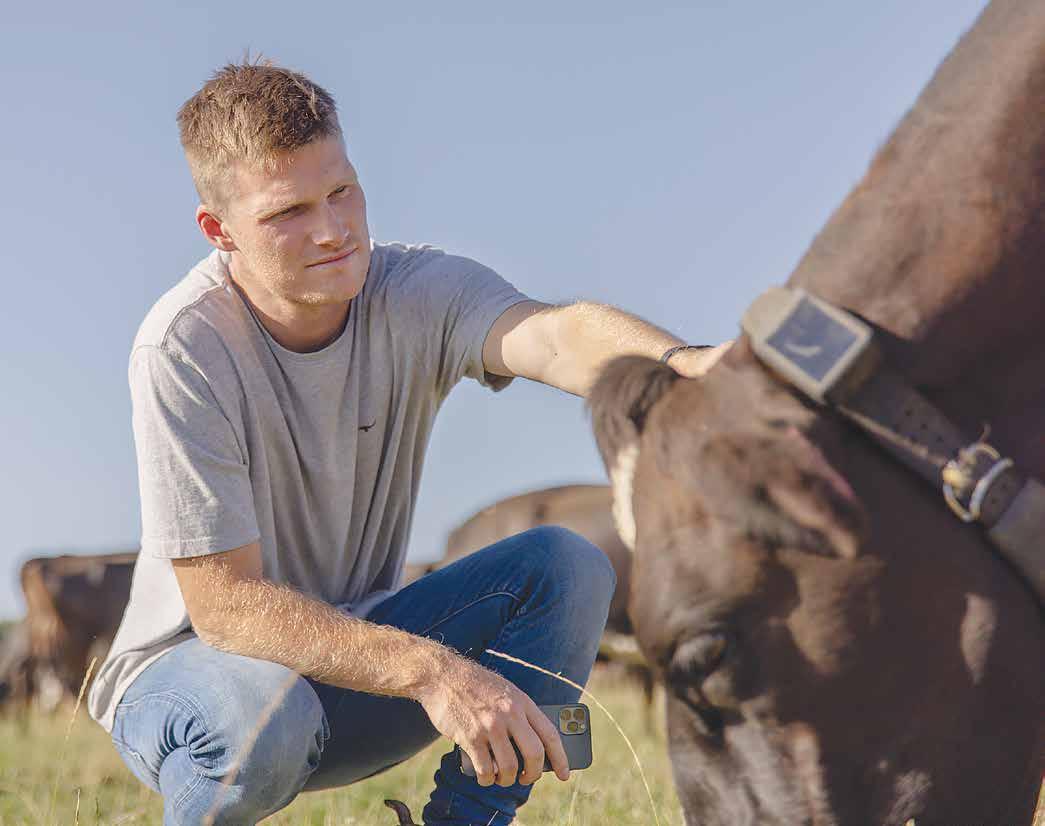




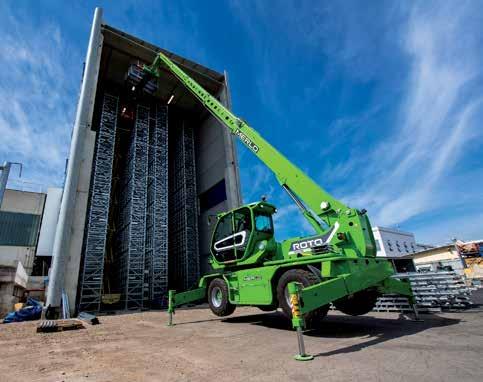

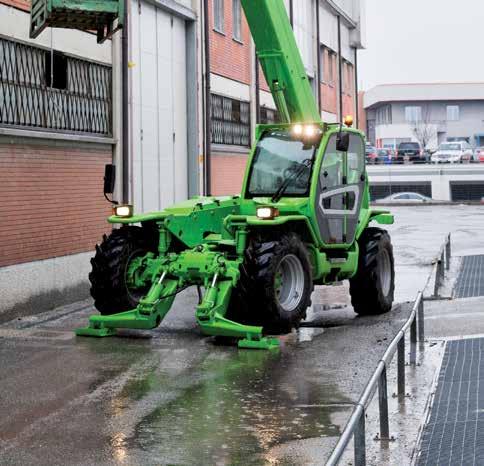
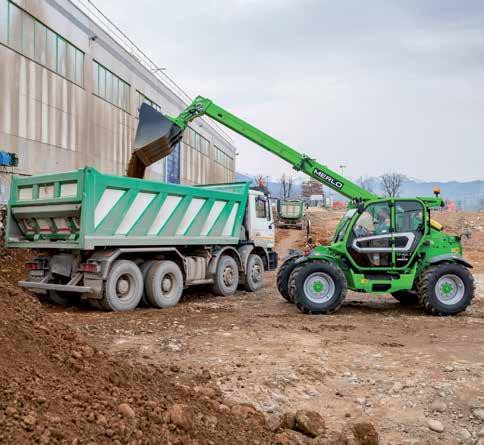




















SUDESH KISSUN sudeshk@ruralnews.co.nz
NEW FEDERATED Farmers national dairy chair Karl Dean is looking forward tackling the issues facing the sector.
Dean, who sharemilks with his wife Amie near Leeston in Canterbury, was elected at Federated Farmers annual meeting in Christchurch two weeks ago.
He has previously held roles as Federated Farmers North Canterbury provincial president and vicechair of the national dairy council.
“It’s a real privilege to be elected to the board, and I’m genuinely excited about the opportunity to help lead a constructive and futurefocused dairy council,” Dean says.
He takes over from Richard McIntyre, who stepped down after three years in the role.
“It’s also been a huge honour to work with Richard McIntyre over the past seven years on the dairy council, and his 12 years of service hasn’t gone unnoticed.
“His leadership has helped shape a strong, positive culture, and I’m committed to carrying that legacy forward.”
Feds president Wayne Langford says it’s exciting to have a capable young leader like Dean stepping up into a national leadership role.
“While he’s new to our national team, he’s by no means new to Federated Farmers. Dean has held senior leadership roles within our organisation for some time now.
“Dean is a highly respected and experienced farmer within his region and has worked his way up from the grassroots.
“I have no doubt he’ll make a

huge contribution.”
Meanwhile Dean’s election to the national role saw Bex Green step up as North Canterbury’s president.
Green, who contract milks 1000 cows with her husband Blair in Culverden, was the province’s vice president under Caroline Amyes.
“Dairy farming is my passion, but I’m really excited that as president I’ll get to broaden my horizons and come to grips with the issues
in meat, wool and arable as well,” Green says.
“In many respects, farmers are farmers no matter what we produce. Many of the issues, challenges or opportunities we have in front of us are shared.”
Named Federated Farmers 2024 Dairy Advocate of the Year for her leadership on issues such as a streamlined path to work in the dairy sector for immigrants, Green
A FORMER Fonterra executive is the new chair of the Dairy Companies Association of New Zealand (DCANZ).
Guy Roper takes over the reins from Matt Bolger, who stepped down at the end of last year following his appointment to Fonterra’s senior management team.
Roper is an experienced director, with a strong background in the dairy industry and important role in the supply chain that enables New Zealand’s dairy exports. He’s held a variety of roles in the dairy sector,
including at Fonterra as Global Account Director for Nestlé and as Commercial Director of Global Trade and Ingredients, as well as a farmer-elected director of the former Kiwi Co-operative Dairies, one of the two co-operatives that merged to form Fonterra.
Brendhan Greaney, Tatua chief executive, speaking on behalf of the DCANZ executive committee, says DCANZ is pleased to welcome Roper to this role.
“His governance capabilities, combined with a wealth of relevant
says she is keen on tackling the challenges within meat, wool and arable.
“I like to have a goal in front of me. That’s what keeps me focused and motivated. There’s also plenty of support for me to call on when I need it too.
“Federated Farmers have a very strong team in North Canterbury, and we’re definitely looking to build on that and grow our membership and engagement in the community.

knowledge and experience from previous executive roles, and his general passion for improving New Zealand’s prosperity through trade, will be important assets for DCANZ,” he says.
Roper says he’s excited to have this opportunity to contribute to a sector that he believes in and identifies with.
“The dairy industry plays an important role in New Zealand, and the leadership of dairy companies matters, especially in challenging times,” he says.

SUDESH KISSUN sudeshk@ruralnews.co.nz
VIRTUAL FENCING
company Halter is going global but for founder Craig Piggott, New Zealand farmers will always remain their main partners.
His company, now valued over $1.65 billion and growing, still gets feedback from New Zealand farmers on how to improve and enhance features on its worldleading cow collars.
“New Zealand farmers are, like, at the centre of
it. They’ve been partners, effectively, the whole way through and they give us feedback on the product every day,” Piggott told Dairy News.
“They are constantly asking for new additions: we get them up to the office and our staff spend heaps of time in the field with customers.”
Piggott says farmers are the reasons the Halter teams get out of bed in the morning.
“We live to serve them,” he says.
Piggott’s first customers- his parents – still farm in Waikato







MyVitality supplements are formulated, tested, and bottled right here in New Zealand.
For over 6 years, Kiwis have trusted us to support healthy aging – with proven ingredients, science-backed quality, and products that help you stay active on the land and at home.
and are still using Halter. In some regions of NZ, about 30% of farmers are using Halter cow collars to move cows between paddocks without the need for fencing, boosting pasture efficiency and production.
The Halter system includes a solar-powered smart collar for each cow, towers for connectivity, and an app that lets farmers manage their cattle and pasture from their phone. Cattle are guided by the collar’s sound and vibration cues. Farmers can virtually fence, move, and monitor their cattle 24/7.
Piggott says sales in NZ are strong with more farmers embracing the technology.
“We are building more collars and deploying more farms and selling more than we’ve ever had before.”
The company is also selling collars in Tasmania, with 25% of the cows on the Australian state wearing Halter collars.
Other Australian states are opening up to virtual fencing, with regulatory changes in the pipeline.
“Tasmanian farmers have been super successful with the product, and I think they’ve played a huge role in helping to show the mainland Australia states the potential of the product,” says Piggot.
Piggott grew up on the family farm and has a deep passion for farming.
In 2016, he left his job, raised $150,000 and
launched Halter.
He’s happy with where Halter is placed in 2025 but is always looking on improving the product.
“I think we’re always looking to do more, and it feels so early on the journey.
“There’s a lot more product that we want: we want to keep improving the system and keep building more features and more things.”
Last month Halter announced that it had raised $165 million in a new round of funding with key investors.
Piggott says the new capital will help unlock more productivity gains for farmers.
“Halter was built with our early farmers – we wouldn’t be here without them. We’re deeply grateful for their trust.
“Halter farmers are more profitable and get better outcomes for the environment and their animals.
“Farmers use Halter to grow and harvest more grass, reduce workload, increase herd size, improve animal health and welfare, and unlock environmental benefits,” says Piggott.
“Farmers are the backbone of rural communities.
“They feed society and play a key role in building sustainable food systems. Halter farmers are pioneering a more productive and sustainable way to farm.
@dairy_news
facebook.com/dairynews
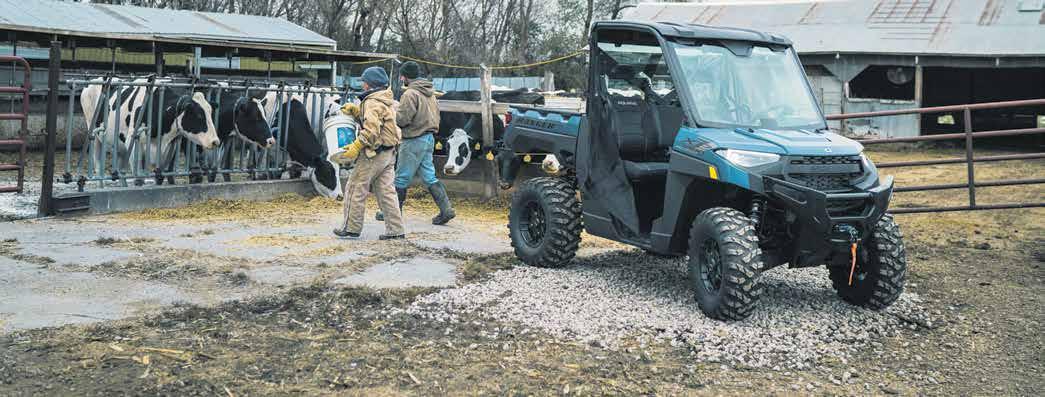
•
are shoring up their balance sheets, with almost $1.7 billion of debt repaid in the six months to March 2025.
This equates to the average dairy farmer reducing their debt - from around $22/kgMS in 2016 to $18.40/kgMS in 2025.
ANZ managing director business and agri Lorraine Mapu says the significant debt reduction indicates real momentum and places the sector on a much stronger footing.
“What we’ve seen from many of our farmers is that they’re shoring up their balance sheets and getting themselves ready for what they need to face into in the future,” Mapu told Dairy News.
Fonterra is forecasting a final milk price of $10/ kgMS for last season. It’s also forecasting a record
opening milk price of $10/ kgMS for the new season, which started June 1. A $10/kgMS milk price for last season equates to around $15 billion into the New Zealand economy. Apart from paying down debt, dairy farmers are also looking at investing in technology and how it can be used to improve their businesses.
Mapu says around the boardroom or kitchen table, these strong returns have opened exciting options and investment opportunities for many of the bank’s customers. At the recent Fieldays, many farmers who visited the ANZ tent spoke about technology.
“There is a lot of talk about technology. In previous years you’d come to Fieldays and everyone would talk about tractors and hay balers and motorbikes, now they’re talking about software technology on-farm,” Mapu says.

For ANZ, this is key is helping farmers look towards the future.
“For those who have debt positions shored up and are looking to invest, they are looking to the future and thinking about




whether technology is one of the things that will help improve their farming operations,” she says.
“There’s so much technology that’s coming to the farm and to the orchards that can really
help them improve and I think that’s going to be game-changing.
“We want to help our customers understand what some of that technology is, how does it work on the farm or orchard, and how will it benefit my business.”
The boost in dairy income has also given a boost to the real estate market.
In both Canterbury and the Waikato, the market for first-farm buyers is the strongest it has been in some time.
Mapu notes that many sharemilkers are stepping up to purchase their first farms - a trend supported by share and contract milkers who have built up equity in recent years, enabling them to acquire land either independently or with the backing of a larger partner.
“Land sales have also been active, with a growing number of dairy farmers looking to expand, including well-established families in the region aiming to grow from owning one dairy farm to two or three.
“Often, these are farmers who have weathered the highs and lows of the economic cycle and are now able to expand once again.
“Another thing we’re seeing is significant interest in innovative new technologies, including wearables, AI-powered cameras, and bolus technology, as farmers seek to leverage real-time data to improve efficiency on the farm.
“We’re also seeing increased interest in rebuilding or replacing ageing milking sheds, particularly in Canterbury.”
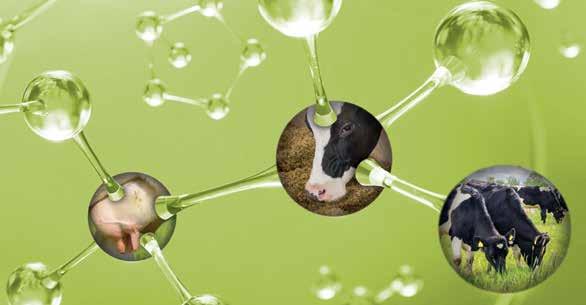

A LEADING financial and banking advisor says he doubts if most dairy farmers fully understand the dynamics of banking.
Speaking at a day-long seminar in the Taranaki town of Hawera, organised by DairyNZ and the Dairy Trust of Taranaki, Andrew Laming told the gathering of more than 200 people that the way banks assess credit is a mixture of science and art.

Laming says the risk in such a situation is that a farmer, turned down for a purely subjective reason, may feel that their proposal is no good, which may be far from the truth. He says when it comes to dealing with banks, farmers should look at taking advice from people who know the intricacies of the banking system and what goes on behind the scenes.
“Someone who speaks bank lingo,” he says.
WHILE THERE is a trend to family corporates in the dairy sector, Andrew Laming says large doesn’t necessarily mean best performance.
He notes that some of the best performing dairy farms are run by a husband-and-wife team because they have the ability to drive costs down. But when it comes to issues such as environmental management, Laming says banks tend to like the larger groups because the chances are they will have dedicated staff to handle some of the complexities in this area.
“The challenge is – how can we simplify this?” he says.
To better manage issues relating to the environment and remain profitable, Laming believes one of the roadblocks is the lack of capital.
Laming is a founding director of NZAB which claims to know every bank and every rate better than anyone in the market. Laming says their business is about helping farmers understand what a genuinely better banking deal looks like—not just on price, but on structure, terms, and flexibility. He says when assessing the credit of a farmer client, banks consider some of the objective numbers but also some subjective stuff, so there’s a lot of interpretation that goes on.
“And sometimes it’s not even about a farmer’s own
property. Sometimes it could be about their region or it just might be the subjective view of a particular bank. For example, if that bank had a book full of dairy loans, they may be negative to an individual proposal regardless of its merits,” he says.
Laming emphasises that he’s not criticising banks as such, but is pointing out that it’s more than just getting a good interest rate for a loan. He says in the case of NZAB, loans are the tip of the iceberg in terms of their work.
He says their goal is to help businesses become more bankable and help them access capital on the best terms possible.
“Banks do like them because, if it’s large, the chances are it will be a well-governed business, often with independent advice around it, and they (the banks) can make some very good risk assessments on the business,” he says.
He says one of the prime issues facing the dairy industry is the huge amount of data and other information that keeps coming at farmers – about a raft of new rules, regulation and potential solutions to deal with these.
He says some changes are occurring, for example, banks are offering interest free loans for installing solar systems and lower interest rates for other ‘green’ projects. But he says the reason rural loans are higher than a normal mortgage is that rural is deemed riskier and because banks must hold more capital in reserve to protect themselves.
He says changes to the banking system in NZ may help, but he believes that access to overseas capital and more hybrid loan arrangements will be needed in the future. He says this will particularly apply as older farmers exit the industry and the next generation takes over the business. Laming says the issue of succession is complex and ensuring that all parties get a ‘fair deal’ will require new and innovative financial instruments.
QUESTIONS ARE being raised about just how good the state of the dairy industry is – especially given that the average farmgate payout for the coming season is set to exceed $10/ kgMS. Also, the fact that this past season has been a record one for export returns.
Andrew Laming, a director of NZAB, a financial advisory service company specialising in farming, is one such person. He says the $10 payout needs some context put around it. For a start, he agrees the NZ dairy industry is in good heart with an inflation adjusted payout for five years of about $9.20, which means that margins are above longterm averages. He also notes that debt levels in the sector are a bit
lower, along with interest rates.
“The result is that you have got a lot of cash floating around in this business,” he told Dairy News.
“Having said that, 15 years ago there was a lot more investment and expansion in farms but now we are seeing that money is being used to repay debt and also being used to do a bit of off-farm investment,” he says.
While this all looks quite rosy, Laming says that people need to realise that the $10 payout is good but not great in comparison to past years. He says there were better payouts in 2013-14 that were much higher than the inflation-adjusted average at the time.
The same perspective is shared by DairyNZ’s head of economics Mark
Storey, who says while the breakeven forecast for the coming season is still positive, his analysis highlights notable annual increases in some key farm expenses. He says these are being driven by higher tax obligations, due to higher returns, and increases in general farm working expenses – particularly in feed, fertiliser, and energy costs.
“As a result, DairyNZ’s forecast breakeven milk price has risen from $8.41/kgMS in the 2024-25 season to $8.68/kgMS in the 2025/26 season, which is a significant year-on-year increase. We are predicting an average payout of $10.21/kgMS and average farm working expenses of $5.84/ kgMS,” he says.
Storey says despite the elevated
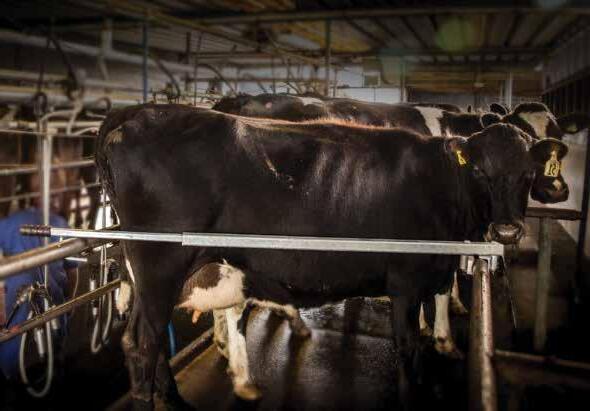
costs, the outlook for the 2025/26 season remains positive, with robust milk price forecasts, and farmers likely to benefit from reduced debt levels and easing interest rates. He says these conditions should support continued debt reduction, reinvestment on-farm, and adjustments to personal drawings to manage inflationary pressures.
But at the same time, he cautions that the scale of cost increases over the past 12 months is concerning, and global volatility adds uncertainty to the months ahead.
Storey says fertiliser prices, for example, have increased sharply due to global supply constraints, export restrictions from China, and increased natural gas prices.
He says, compared to May last year, phosphate prices are up 34% and urea 40%. He also notes that crude oil prices have also recently surged by 17% due to instability in the Middle East.
“Given New Zealand’s reliance on imported fuel, dairy farmers should allow for potential cost spikes, especially during peak operational periods,” he says.
DairyNZ chair Tracy Brown said the farmers she’s been speaking with are following global events closely. She says with continued uncertainty in global markets and pressure on some key expenses, it’s important farmers plan and build flexibility into their budgets where possible.
– Peter Burke
onstrates potential to provide net benefits to society.
TURE Commission
has endorsed a plan by Chorus to expand fibre broadband to 95% of New Zealand much to the delight of rural women.
The endorsement is part of the Commission’s Infrastructure Priorities Programme (IPP) and supporters say it recognizes rural connectivity as a critical national issue.
In its assessment, the Infrastructure Commission gave the proposal a green rating for value for money, meaning that it has a strong Benefit Cost Ratio.
“The proposal dem-
“This is due to an early option being explored that has an estimated value to society that is likely to exceed its estimated cost,” the Commission wrote in its assessment.
The proposed expansion would bring fibre to approximately 160,000 more addresses, many of which are in regional and rural New Zealand.
Rural Women New Zealand (RWNZ) national president Sandra Matthews says the endorsement is a “big boost” to the addressing of what she says is a long-standing digital divide faced by rural communities.
“Reliable and high-
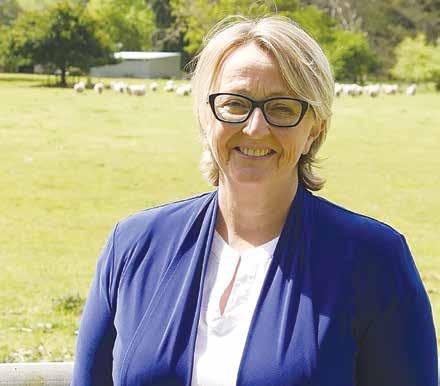
speed internet is essential to the success of rural businesses, the delivery of rural healthcare and education, and the overall wellbeing of our more
isolated communities,” she says.
Matthews says that as



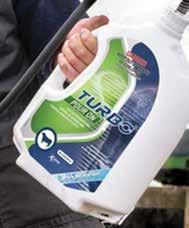
Purchase a 5L of TURBO® or BOSS® Pour-On and receive a NZ Made Far South Oilskin vest*.
technology changes and new opportunities arise through digital connectivity, it is necessary to ensure that rural communities are well-placed to benefit.
“It is therefore critical that government moves swiftly to provide backing to this proposal,” she says.
Chorus chief executive Mark Aue says the endorsement reinforces the idea that digital infrastructure is essential national infrastructure.
“Just like roads and water, fibre connectivity underpins our economy, education, healthcare, and social wellbeing,” Aue says.
He says the project is ready to move forward.
“We’re ready to work
with government again to explore innovative funding models that draw on both public and private capital to extend fibre coverage even further,” Aue says.
He says that with government backing, Chorus would be able to start the project within a few months.
“But it doesn’t have to be all or nothing,” he says. “Our proposal lends itself to staged delivery, allowing investment to be spread over time while delivering real benefits at each step.”
“Reliable, scalable, high-performing connectivity is no longer a luxury; it’s essential. We need a clear plan to ensure rural New Zealand isn’t left behind.”
Using DMI-Sorb™ rain resistant technology, TURBO® and BOSS® Pour On are products you can depend on in New Zealand’s unpredictable weather. Come rain or shine, enjoy the ultimate parasite coverage.

CAUTIOUSLY OPTIMIS-
TIC is how DairyNZ’s regional manager for the lower North Island, Mark Laurence describes the mood of farmers in his patch.
He says weather conditions are ‘benign’ –meaning it’s not been an amazing winter nor a terrible one and June has not been too cold
“I think we are setting up to be in a really nice position for those who calve early,” he told Dairy News.
Laurence says there are some who’ve got
good covers in the region and farmers will be able to take that quality forward and feed their cows well, because farm conditions are good.
“I am quietly confident that if July is the same as June, farmers will get through winter well,” he says.
But Laurence concedes that farmers in the coastal regions of Taranaki, Manawatu and Horowhenua who were hit by drought will face challenges. He says many used supplements to get through the drought and says it’s hard to generalise on the region as it comes down to the circumstances of individual

farmers.
Laurence says there was a reasonable amount of supplement available
in peripheral areas outside Taranaki and because of the high payout, those who were able to source
this feed tended to buy it.
“But there will be some farmers who have used their winter feed and are now crossing their fingers that the weather gods will be kind to them. Others however
may struggle,” he says. Now the weather has been good and Laurence says it is a good time to feed palm kernel expeller (PKE) to stock. He says he’s seen tractors and utes going up and down roads hauling PKE troughs and that is a good sign.
The one thing that is still playing on dairy farmers’ minds is what will happen in the next year. Laurence says the future payout looks good, but farmers are also conscious of the fact that there are rarely two good years in a row and, while optimistic, they are also realistic that with good comes bad.
THIS PAST week has seen another round of negotiations between India and New Zealand to produce a free trade agreement (FTA) between the two countries.
A team of NZ officials from several government departments, led by the Ministry of Foreign Affairs and Trade (MFAT), have been in Delhi for talks with their Indian counterparts. These talks are between officials only and no politicians have been involved in the negotiations.
This latest round of talks is part of the ongoing process to reach agreement on an FTA. Every month there are four or five days of ‘virtual’ negotiations, followed up by face-to-face meetings between the two parties.
The FTA consists of 19 chapters or separate parts and is identical in structure to other FTAs that NZ has secured. The focus ranges from issues around rules, phytosanitary standards, a chapter on composition, services and, of course, trade.



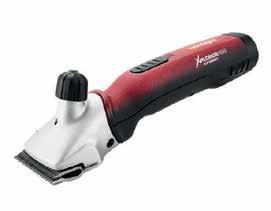
While NZ is pressing for dairy to be included in the FTA, the chances of this are nil, and we are not being singled out in this regard. Britain and Australia, who have FTAs with India, also had dairy excluded from their respective agreements.
A couple of issues on the trade side that NZ is pushing hard on are apples and honey. Currently India imposes a 50% tariff on apples which limits our ability to access that market. While India does produce apples, they are of course seasonal and what the NZ negotiators are trying to do is convince the Indians to allow NZ fruit in only when the local supply dries up.
The NZ position is that having apples on the market for 12 months of the year ensures that consumers have continuous supply which makes good marketing sense.
What NZ is saying is we will fill that gap in local supply and be gone when Indian fruit come on the market. This is an argument that we
have successfully pursued with other primary products in the Northern Hemisphere.
The other issue is honey, and NZ is again trying to get access for manuka honey which has a high price point, well above the local produce.
The FTA with India is seen as a high priority for our government and it’s proceeding at pace. The stakes are high. Over the past couple of weeks NZ will have had about 15 people in Delhi at various stages of this latest round of talks. It’s believed India will likely have double that number of people.
At the same time, the political tempo is being kept up with Trade Minister Todd McClay making regular trips to India along with Prime Minister Christopher Luxon there in March and Deputy Prime Minister Winston Peters there some weeks ago. – Peter Burke



THE WORK Fonterra has done with Ballance Agri-Nutrients Ltd, LIC and Ravensdown to save farmers time through better data connections has been recognised with a national award.
The four partners picked up the “Team and Collaboration Award” at the 2025 Primary Industries New Zealand Awards in Christchurch recently, which more than 400 people attended to celebrate our primary industries.
This collaboration has been all about reducing data duplication for farmers. In the past, farmers often had to enter the same information into different platforms. Now, Fonterra has led the development of what’s called an open data sharing ecosystem with these partners, giving farmers the abil-
ity to submit information once as opposed to multiple times.
Trevor Newman, Fonterra’s general manager farmer experience, says the initiative has saved farmers an estimated 250,000 hours of admin time so far, with another 270,000 hours in time savings possible today, if more farmers choose to use the ecosystem.
“We’ve heard loud and clear from dairy farmers across the country that on-farm admin should be simpler, and as an industry we’re listening,” says Newman.
“It’s great that this project has been recognised by the wider industry, but there’s more work to do. We’re looking to collaborate closely with our farmers and partners to co-design tools and solutions that make compliance tasks

faster and less stressful – so farmers can spend more time on the things
that matter most to them and their business.”
The co-op’s partner-
ship with Ballance, LIC and Ravensdown has been built on some key
principles.
“Most importantly, standing in our farmers’ boots to ensure our solutions address their needs in a practical way,” says Newman. “Other principles include recognising the data belongs to farmers – and therefore they can choose who to share it with – as well as making sure data is kept secure.”
If farmers take the simple steps to set up data connections between Fonterra and these partners, they can pre-populate their annual Farm Dairy Records by as much as 70%. This means time saved on filling out the records as well as the onfarm assessment process. Farm Dairy Records help Fonterra tell the story of what farmers are doing on farm to produce high-quality, sustainable milk, which is important
for customers and other stakeholders. They’re also used to create personalised Farm Insights Report that are shared back with farmers to help them identify any areas for potential improvement.
Around two thirds of Fonterra farmers have now connected their data to one or more partners, and recent feedback says 65% of farmers thought their annual Farm Dairy Records experience was much better than last year.
Fonterra has recently launched new data integrations with CRV, DairyNZ, Farm IQ and Trev to drive further efficiencies, and the co-op expects to be able to share more positive developments in this space in the future.
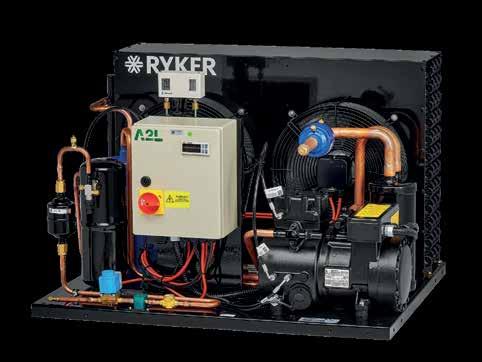
HOLSTEIN FRIESIAN
excellence was front and centre at the 2025 Holstein Friesian NZ (HFNZ) Awards, held recently in Invercargill.
More than 100 breeders, sponsors and supporters gathered at the Ascot Park Hotel to honour standout achievements across the breed — from production and progeny to youth involvement, photography and showring success. The awards night was part of this this year’s HFNZ annual meeting and conference.
The 2025 Valden Cow of the Year was awarded to Rivendell Sham Beatric-ET 4*ET EX3 SP, owned by Cummings Family Trust (Helen and Jock Cummings, Wyndham) and bred by Rivendell Holsteins (Owen and Cathy Copinga).
Chosen from six finalists, 2012-born Beatric was deemed to be the cow that had contributed
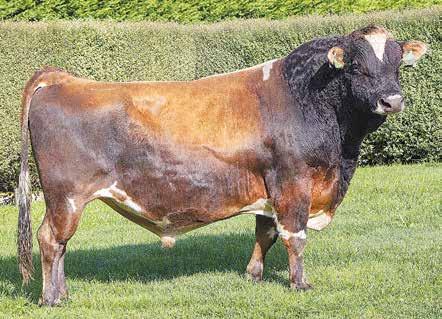
the most to the Holstein Friesian breed on a continual basis.
“It has been a huge honour to have Beatric from Owen and Cathy Copinga,” Helen says.
“Winning the Valden Cow of the Year was a huge surprise and an honour.” Beatric was a much-loved part of the herd, she adds.
“She is certainly one
awesome cow – she is a strong minded and strong-willed type of cow. Being awarded the Valden Cow of the Year is an honour and a privilege.”
The winner of the 2025 Mahoe Trophy was Busybrook Pokerface S3F, bred by Nathan and Amanda Bayne (Henley Farming Company Ltd, Oamaru).
The Mahoe Trophy

is awarded to the New Zealand-bred Holstein Friesian sire whose sire proof, as at the April 2025 AE Run, earns the most points for traits, daughter production, conformation and management.
D & J Gloyn (Deborah and Jeremy Gloyn, Rongotea) were the junior team winners of the 2025 HFNZ-Boehringer Ingelheim Animal Health Progeny Competition, with S-S-I PR RenegadeET on 331 points.
S & J Ray (Stephen and Judith Ray, Balcutha) won the senior team with Seagull-Bay Supersire-ET on 484 points.
These awards are presented to the Junior and Senior Progeny teams with the highest points for classification based on the 2024/25 seasons inspections, scores for udder overall and final score, production worth and protein BV.

CView Trust (Stefan Buehler, Hawera) was the overall winner of the 2025 Nutritech Performance Awards with $6,136.21.
This prize is awarded to the herd owner with the highest dollar earning herd average for their region based on the Fonterra A+B-C payment system for the 2023-24 season.
In the Black & White Youth Awards, Rylee Parkes of Blenheim won the Kingsland Trophy, awarded to the Senior Black & White Youth Member who earned the most points in the 2024 All NZ Calf Class Competition. Rylee was also the overall winner of the 2024 All NZ Black & White Youth Calf Class Competition.
Waihi’s Jacoba Gread was the winner of the 2025 Pitcairns Trophy, and the 2025 Frank Pfister Award for the second
TIMARU-BASED TRONNOCO
Farming Co Ltd is celebrating a standout performance at the 2025 HFNZ-Semex On Farm Competition, with their Holstein Friesians earning places in three of the six national classes.
Winners were at the HFNZ annual awards evening, hosted at Invercargill’s Ascot Park Hotel as part of the 2025 Holstein Friesian NZ AGM & Conference. Among the standout results was Tronnoco Lambda Lilith, who took out the Comestar Leader – Three Year Old Cow title. In the Conant-Acres JY Broker – Mature Cow class, Tronnoco Sonic Glory and Tronnoco
LIC LIVESTOCK selection manager Simon Worth says it’s an honour to have the co-op’s sires recognised.
“Having two of our sires acknowledged in these prestigious awards reflect years, often decades, of hard work by our breeders and livestock selection team to breed the best bulls for New Zealand dairy farmers.
“Bulls who have won these awards in the past have often gone on to sire some of the highest-performing cows in the national dairy herd, and it’s great to see these benefits being delivered back to our farmers year after year, “ says Worth.
Pokerface was sired by the renowned Lightburn Blade Gusto and his dam comes from LIC Hall of Fame sire, San Ray FM Beamer.
Pokerface is known for producing daughters with high production, strong fertility, udders, and capacity. Though he’s no longer available for purchase, Pokerface’s legacy in the New Zealand dairy sector will live on as a sire of sons in LIC’s breeding programme.
year running, which is awarded to the highest scoring youth member at an official Holstein Friesian NZ Judging School.
Three Distinguished Service Awards were also presented at the awards dinner, recognising the dedication and passion of HFNZ members Katy Button, Judith Ray and Helen Cummings. This award recognises individuals who have made a lasting impact through their dedication, leadership, and service to the Holstein Friesian community.
Modesto Cairo were awarded first and second respectively.
Owned by Tony and Keri O’Connor, Tronnoco Farming Co Ltd has cemented its position among New Zealand’s leading Holstein Friesian breeders through consistent excellence in type and structure.
The HFNZ-Semex On Farm Competition promotes the Holstein Friesian breed by judging individual cows at their home properties in natural conditions—without fitting or halters—allowing animals to be assessed in a true production environment.
This year’s event saw 780 cows
from 106 herds evaluated across eight regions. Judging was based on structural correctness using a specially designed linear scoring system. The top two animals in each region advanced to the national final, judged by
Of the six national Champions crowned for 2025, four hailed from the South Island—Rangiora, Timaru and Christchurch—with two from the North Island—Hamilton and Morrinsville—highlighting the strength of the breed across the country. Semex NZ’s Ryan Lett said it was a pleasure to be part of the HFNZSemex On-Farm Competition.
SELECTING THE reverse gear quicker than a lovestruck boyfriend who has met the inlaws for the first time, the Coalition Government has confirmed that the proposal to amend Fringe Benefit tax (FBT) charged against farm utes has been canned.
The National Party decide to rule out Inland Revenue’s proposal to dramatically increase the tax burden on work vehicles, which assumed that they were also being increasingly used for private use.
The sentiment being that the proposal would unfairly target the legitimate use of work vehicles.
While the previous Government’s so called “ute tax” was a one-
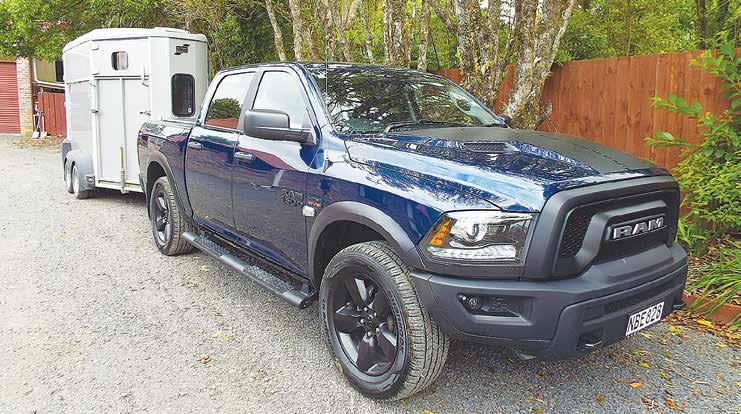
off cost, the latest proposal could have seen utes costing more than $80,000 purchased by a farm business for farmers or shareholders taxed
at 100% of their value (capped at $80,000) even if they were used almost exclusively for farm use.
The result would potentially result in an
estimated tax burden of between $5,500 and $8,200 per annum.
Meanwhile, employees and sharemilkers supplied vehicles, under
the proposals, would be liable for a tax liability of $1,800 to $2,700 annually on a $50,000 value vehicle.
Following the IRD
consultation period that ended in early May, many of those likely to be affected and their financial advisors waited for clarification on what
constituted work and private use.
At the time, it was suggested that under the new proposals, if a Ute left the farm to head into town to source fencing materials or calf feed supplies, the off-farm journey, to and from town would be private use. This was even though the vehicle was undertaking a transport function as part of the farm operation.
In a statement, the National Party went on to comment that it would not be hitting any Kiwis with new tax burdens on utes-full stop-and that included changes to FBT changes.
The decision to walk away from the proposal would appear to suggest that the government, and particularly the National Party, are listening to the rural industries.
@dairy_news
COMPENSATION ASSISTANCE for farmers impacted by Mycloplasma bovis is being wound up.
The DairyNZ Beef + Lamb New Zealand Compensation Assistance Team (DBCAT) was set up in 2018 to help farmers prepare compensation claims during the M. bovis outbreak.
During the past seven years, 1370 farmers have used the free service with more than 2310 claims being finalised.
More than $161 million in claims were submitted by the service on behalf of farmers, including $88 million from dairy farmers and $40 mil-
lion from beef farmers.
It is estimated that the service saved the M. bovis eradication programme more than $10 million by finding smart farm-systems solutions that mitigated the need for a claim.
DairyNZ head of biosecurity Fi Roberts says the service played an important part in supporting farmers through a tough time.
“We know how hard it was for farmers, which is why we wanted to support those affected by getting them through the compensation claim process as quickly as we could.
“By having a dedicated team,
claims could be processed faster and farmers compensated more quickly,” she says.
DairyNZ chair Tracy Brown says eradicating M. bovis has been one of the most significant biosecurity challenges the sector has ever faced.
“That’s why it was important that the service was operated independently of Government so we could provide specific advice and guidance to help farmers through.”
Beef + Lamb New Zealand chair Kate Acland said DBCAT played an important role in helping farmers navigate what was one of the tough-
est times in their farming careers.
“The service not only made the compensation process more accessible and efficient, but it also ensured farmers had someone in their corner who understood their operation and their stress. We’re proud of the partnership that delivered this support and of the legacy DBCAT leaves in showing how the sector can come together in a time of need.”
DairyNZ partnered with the Ministry for Primary Industries (MPI) and Beef + Lamb New Zealand to lead the response phase of the M. bovis eradication programme.
The M. bovis programme is now seven years into a 10-year eradication plan, with currently no active, confirmed properties. The programme transitioned to the M. bovis National Pest Management Plan (NPMP) on 1 January 2025, which OSPRI is implementing.
The DBCAT service closed on June 30 with MPI directly handling any new or unresolved claims.
Lessons learned and expertise developed within all the partners continues to inform planning for future incursions, such as Foot and Mouth Disease.


THE GOVERNMENT’S decision to rule out changes to Fringe Benefit Tax (FBT) that would cost every farmer thousands of dollars annually, is sensible.
Inland Revenue’s proposal was to make major changes to the way FBT applies to utes, which are common and essential work tools for most farmers across New Zealand.
As Federated Farmers rightly points out this could very quickly become a ‘Ute Tax 2.0’ and it seems to be being pushed through by stealth.
That old chestnut!
JUST AS it’s healthy for cockies to get out of the shed and off the farm occasionally to get a fresh perspective, Milking It reckons some academics would benefit from spending a few days in the real world. You can set your watch to it; when dairy farmers finally get a good farmgate price, some wonk will attack them for ‘profiteering’ on the domestic market because the price of their cheddar wedges goes up. Auckland uni professor Rob MacCulloch is just the latest to roll out the old socialist chestnut that farmers should sell locally at a lower price than they can get overseas. No mention of the fact NZ dairy farms are privately owned businesses, built by hard-working risk takers; they’re not communist state assets. And when dairy farmers make a loss, the MacCullochs of the world are strangely silent.
A LAST-MINUTE compromise ensured that the election of new Federated Farmers national dairy chair wasn’t a repeat of the Super 15 rugby final – Canterbury versus Waikato.
Waikato Feds president Phil Sherwood withdrew his nomination hours before the annual meeting in Christchurch last month, allowing North Canterbury provincial president Karl Dean to take the top job unopposed. However, the same cannot be said of Feds meat and wool group – sitting chair Toby Williams was voted out before the completion of his threeyear term by Malborough farmer Richard Dawkins. Traditionally, Feds leaders are allowed to serve three years in a role before stepping aside for new blood. Williams had been on the job for two years and eight months.
AN ANIMAL activist organisation is calling for an investigation into the use of dairy cows in sexually explicit content posted on social media and adult entertainment subscription site OnlyFans.
Save Animals From Exploitation (Safe) is petitioning the Ministry for Primary Industries to stop the people producing video content of a sexual nature directly involving cows.
The organisation said it was “deeply concerning” to see the mother cows who are “already being exploited for their reproductive systems” being further victimised by the videos.
The videos, some of which have been seen by one local media, show women in bikinis performing routine farm tasks such as milking cows and sweeping the milking shed.
The Ministry for Primary Industries (MPI) was now speaking to the social media content creators about the footage and have also referred the content to police for their assessment.
YEARS OF floods and low food prices have driven a dairy farm in England’s northeast to stop milking its cows and instead charge visitors to cuddle them.
According to Reuters, Dumble Farm started as a dairy farm in the 1970s, but in recent years, flooding washed out crops and killed off the type of grass the cows like to eat, while milk prices below cost of production proved an insurmountable challenge.
“The amount of flooding and the pressures on our land were just making it unsustainable for us to carry on,” said farm coowner Fiona Wilson.
Agriculture is one of the sectors worst-affected by climate change, with farmers in Europe and elsewhere suffering under increasing heat, drought and flooding. In 2022, Dumble Farm sold all but a few of its dairy cows and, in a scramble to reinvent itself, began offering “cow cuddling” experiences to fund a wildlife conservation scheme.
For £95 (NZ$213), visitors can cuddle, brush and stroke the cows, as they lie down on a straw-covered enclosure inside a barn. The experience includes a safari to see Highland cattle.
Publisher: Brian Hight Ph 09-307 0399
General Manager: Adam Fricker Ph 021-842 226
Farmers made it clear that they were in no mood to pay thousands of dollars of additional tax payments each year. This would have come as a huge cost for farmers, tradies and other productive New Zealanders and unfairly punish the legitimate use of these work vehicles.
The Coalition Government heard the message, confirming the proposal to amend FBT charged against farm utes has been canned.
While the previous Government’s so called “ute tax” was a one-off cost, the latest proposal could have seen utes costing more than $80,000 purchased by a farm business for farmers or shareholders taxed at 100% of their value (capped at $80,000) even if they were used almost exclusively for farm use.
The result would potentially result in an estimated tax burden of between $5,500 and $8,200 per annum. Meanwhile, employees and sharemilkers supplied vehicles, under the proposals, would be liable for a tax liability of $1,800 to $2,700 annually on a $50,000 value vehicle.
Common sense has prevailed and the Government deciding that it would not be hitting any Kiwis with new tax burdens on utes-full stop-and that included changes to FBT changes.
The Government must be commended for listening to the rural sector. Farmers, already facing an avalanche of regulations and taxes, can breathe a sigh of relief.
Head Office: Lower Ground Floor, 29 Northcroft St, Takapuna, Auckland 0622
Phone 09-307 0399.
Postal Address: PO Box 331100, Takapuna, Auckland 0740
by: Inkwise NZ Ltd Contacts: Editorial: sudeshk@ruralnews.co.nz
: davef@ruralnews.co.nz Rural News on-line: www.ruralnews.co.nz
Subscriptions: subsrndn@ruralnews.co.nz
Editor: Sudesh Kissun Ph 021-963 177
Machinery Editor: Mark Daniel Ph 021-906 723
markd@ruralnews.co.nz
Reporters: Peter Burke Ph 021-224 2184 peterb@ruralnews.co.nz
Subscriptions: Julie Beech Ph 021-190 3144
Production: Dave Ferguson Ph 027-272 5372
Becky Williams Ph 021-100 4831 Digital Strategist: Jessica Marshall Ph 021 0232 6446
AUCKLAND SALES CONTACT: Stephen Pollard Ph 021-963 166 stephenp@ruralnews.co.nz
WAIKATO & WELLINGTON SALES CONTACT: Lisa Wise Ph 027-369 9218 lisaw@ruralnews.co.nz
SOUTH ISLAND SALES REPRESENTATIVE: Kaye Sutherland Ph 021-221 1994 kayes@ruralnews.co.nz
RUMINANT METHANE
mitigation tools were a bit of a joke when first proposed; surely no one would be foolish enough to interfere with nature at its best. Any such propaganda from our sector on mitigation went straight into file 13.
Be warned. The boffins, bureaucrats and levy groups have been working behind the scenes on your behalf, on your dollar, in a bid that is wasting millions on pills and potions that we don’t need, all the while decrying “we won’t hit you with a methane tax”. Vax or tax, it’s the same thing.
Compulsory use of mitigation tools is arriving. In fact, Beef+Lamb NZ have been offshore, shaking hands with heavily subsidised feedlot
farming sectors that are about to mandate the use of chemical feed additives in a bid to chase headlines and methane rainbows. Stealth and subterfuge. The frog in the kettle is glowing rosy red.
“All ‘suitable’ British cattle will be given methane-reducing chemical Bovaer or Bovaer-like products by law by 2030, under controversial Government plans”.
“A Department for Environment Food and Rural Affairs (DEFRA) document that details the plan to mandate the use of ‘methane-suppressing feed products’ in English cattle has sparked concern on social media — due to claims the substance can leach into milk, causing health problems.”
Surely this is a world away from our free-range,
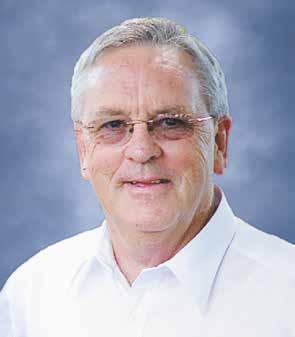
pasture-raised “Taste Pure Nature” brand? Are we that crazy that we are prepared to throw farmers under the bus of alarmist-modelled, catastrophic global warming chasing compulsion, demanding farmers round up all their live-
stock and wrestle a bolus down their gullet at a cost of over $1 billion/ year. Good luck with that. Here’s hoping ACC levies will cover broken arms and dislocated shoulders.
Having raised bulls to two and half years of age many moons ago, there is
no way I would have ever brought them in to vaccinate them or try and ram a bolus down their neck.
It seems strange that the Greens haven’t cottoned on that any such interference with ruminant methane is a trojan horse towards more intensive, housed, feedlot farming.
Companies like Silver Fern Farms and Fonterra state they have to force farmers to take action over the 4 millionths of a degree a year warming they may be responsible for one day because their customers are demanding it. Really?
Meanwhile their more courageous competitors exporting stock and milk into those same offshore markets say “bollocks”. There is no such demand. Consumers want naturally-raised, safe food and value for money and an
Seaward Downs is a small Southland farming community on the banks of the Mataura River some 8kms Southwest of Edendale and half an hour from Invercargill. Hamish Blackmore and his brother have been managing their family farm for more than 15 years. They converted to dairy from sheep and beef and have been running a milking herd of 750 cows.
Like many farms in the district, Hamish grows beet for winter feed because it’s a high-yielding crop and good value. The farm, however, had been struggling with a severe wild turnip issue over the years, which was affecting the beet yield. In 2023, on advice from their local PGG technical field rep, they decided to trial the CONVISO® SMART System, to control the wild turnip and reduce the number of sprays.
Hamish explains:
“The benefits of using the CONVISO SMART System are that it can control the wild turnip, which we have historically had issues with on this property. And obviously being able to
control the wild turnip, it increases our yields, and another benefit is fewer sprays that need to go into that crop.”
While at the time of the interview, Hamish had yet to graze the CONVISO SMART Sugar beet crop, Hamish is already impressed by how the paddock looks.
“The CONVISO crop is looking good. It’s still got a dark green colour and it’s very uniform and clean…we’re looking forward to seeing how it goes.”
The numbers are stacking up too. It doesn’t take too much effort to realise the cost savings of using the new system, and Hamish is already a convert.
“I would definitely recommend the CONVISO SMART System to other farmers because of what I said: it controls the wild turnip, which can be very expensive and actually the growing of the crop is going to be considerably less compared to the conventional growing of traditional beet.”
assurance somewhere in the background that we have emissions covered off. We have. Job done. Or haven’t the growing numbers of ‘comms’ staff at our two biggest exporters got onto that yet? We suggest this ‘consumer call’ is just another ruse to cut prices paid to us, impose differential pricing and ramp up corporate control.
If only we had put more time into promoting our world-leading, natural food-based emissions profile, our plummeting natural emissions trajectory, and our lowinput, low-impact food production systems instead of sending our sector straight to the gallows. The billion dollars feeding a bloated methane scientific sector and their admin could be better spent extolling our advantages.
Farmers are an integral part of the carbon cycle, sequestering CO2 growing grass and crops, they are already net zero. The minor sniff of ruminant methane from our stock continues to fall and has done for 20 years.
Our message to farmers is – “wake up and take action”. It is not too late. Support the Methane Science Accord and Groundswell demanding accountability and common sense from the corporate cocktail club and your MP. Get out of the Paris Accord. We never belonged there, anyway.
Ring the alarm bells before they ban the bell. • Owen Jennings is former National President of Federated Farmers and ACT MP. He’s also a member of Methane Science Accord and Groundswell.
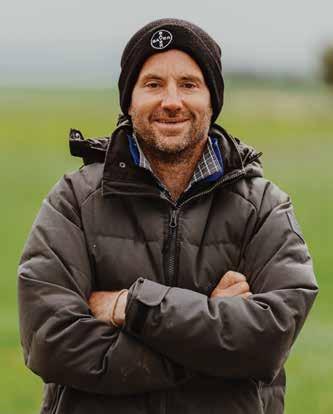

BOUTIQUE WAIKATO
cheese producer Meyer Cheese is investing in a new $3.5 million facility, designed to boost capacity and enhance the company’s sustainability credentials.
Milk processing, cheese making, packaging, storage and delivery will come under one roof, enabling the company to make a bigger range of products and seamlessly go from milk arriving for production to it being aged and ready for consumers. Meyer Cheese general manager Miel Meyer says the new building will have the capability of holding 160 tonnes of products.
Meyer Cheese was started on a family farm in Temple View in 1976 by Miel’s parents Ben and Sophia (Fieke). Now retired, the couple still live on the farm and are used as an important sounding board by Miel.
Miel says the family was shocked when they first heard the price tag of the new building, but they decided to go ahead with the investment to future-proof the business for the next generation.
Sustainability is a feature of the new building the entire roof can be filled with solar panels

Meyer Cheese picked up five awards. They won:
■ The IXOM Champion European-Style Cheese for Meyer Cheese, Maasdam
■ IFF Champion Farmhouse Cheese with Meyer Cheese, Smoked Gouda
■ FSQSNZ Champion Aged Flavour Added Cheese for Meyer Cheese, Fenugreek
■ Woolworths Sustainability Champion
■ Their assistant cheesemaker Jarvis Whyte was named Innovative Packaging Aspiring Cheesemaker.
Miel Meyer says Whyte is a wonderful worker and deserves the credit.
“We are so happy for him whether he stays with us or sees a future in a big dairy company he’ll contribute positively.”
Whyte is the third generation from the family to work for Meyer Cheese; his grandmother and mother have both worked at the cheese company.
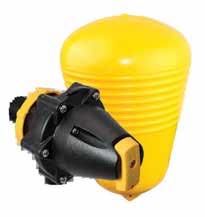
•Ideal for Cattle Troughs
•High Flow
•Side/Bottom Mount
•Detach to Clean
•Compact/Robust

and the company is looking at collecting gas from the effluent system to harvest energy.
One thing that’s not moving is Miel’s office. “I will still have the view over the farm it looks lovely, but the reason for that is actually to manage the animals, the cows and the grass. If I can see problems, I can deal with them,” he told Dairy News. The Meyer family farm employs sharemilkers Josh and Ashley who, along with their kids, milk 395 cows, down from a peak of 550 cows to make the farm self-sufficient in feed.
Miel says cow numbers were reduced despite
the high milk price.
“We do this so that we only feed the animals from the platform and so we don’t need to import food, and the only way we can achieve that is reducing the cow numbers.”
Milk is piped underground from the milk shed to the factory, meaning fresh milk travels less than a kilometre before being turned into cheese. The company buys sheep and goat milk from other farms. Extra conventional milk is purchased from Fonterra and selected nearby farms. Meyer Cheese makes cheese from cow, sheep and goat milk.

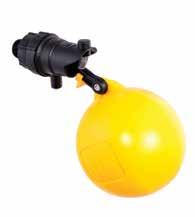
•Ideal for Small/Low Demand Troughs
•Low Flow
ve/Below Water Mount
•Built in Check-Valve
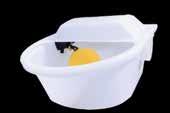
AT THE recent NZ Champions of Cheese Awards, Meyer Cheese picked up the Woolworths Sustainability Champion award, which recognised a cheese producer embedding environmental stewardship into business practice.
The judges’ note to Meyer Cheese said: “The judging panel was impressed by your holistic, Pasture to Plate approach, which demonstrates a commitment to sustainability at every stage of production. Your longstanding legacy of environmental consciousness, dating back to the company’s founding, is a testament to your genuine dedication”.
Miel Meyer says winning the award was an honour and a nod to the work done by his parents, who have always been planting trees and fencing waterways on the property. The company also funds planting by Friends of Barrett’s Bush on soil not suitable for grazing in the area.
“Fencing streams and planting native trees, I mean we never did it to necessarily be sustainable, my parents were doing this since I was a child. And now it’s cool to be sustainable,” says Miel.
His parents’ European (Dutch) heritage also plays a part.
“It’s a natural thing my parents are passionate about. Europe is probably 10 or 15 years ahead in terms of pushing the regulations around sustainability and the environment,” says Miel.
“Mum and dad have always realised that we generate our income and our product from the land. The least you can do is take care it.
“That’s quite an important feature of what they want to achieve. So, winning the award is awesome, but it comes at a cost too.
“This year we reduced the cow numbers and there are two things that have happened – less stress on the land and less money in our pocket.
“So, at the cost of profit, we have made decisions for the better of sustainability.
“It’s difficult to make decisions because sometimes sustainability does have a cost but there’s also a cost of not doing it.
“I’m glad that my parents have set a policy in place where every decision in the company and the environment must be flagged. So, if you’re deciding, hey, we’re going to make a new style of cheese or we’re going to employ someone, whatever it is, you have to consider the environment.””


•Ideal for Compartment Troughs/Tanks
•High Flow
•Top Mount
•Detach to Clean
•Compact/Robust
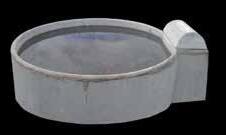
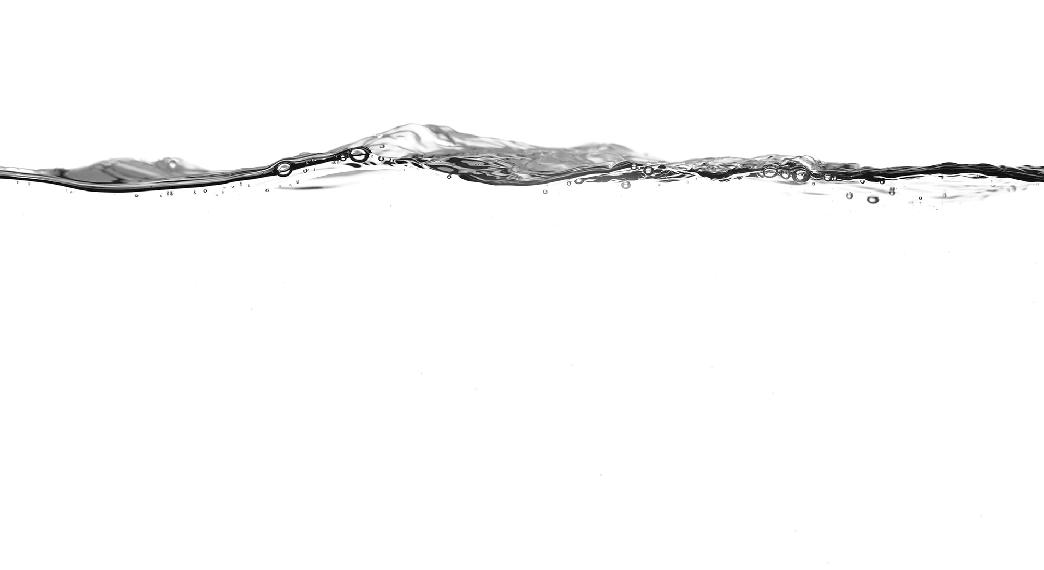
WITHIN THE next 10
years, New Zealand agriculture will need to manage its largest-ever intergenerational transfer of wealth, conservatively valued at $150 billion in farming assets.
That’s according to the new ‘Changing of the guard’ white paper by agribusiness banking specialist Rabobank. It reveals that over this time, approximately 17,320 New Zealand farm and orchard growers –more than half the country’s total – will reach the age of 65.
Rabobank New Zealand chief executive Todd Charteris says the findings highlight the extent of the succession challenge ahead for the agricultural sector.
“Succession is not a
moment in time – it’s a process that takes years of planning, conversation and adaptation.
“The traditional model of passing the farm to the next generation is under pressure, but there are new and innovative models emerging that can help families stay connected to their land.”
The fourth in a series exploring the opportunities and challenges faced by New Zealand’s primary industry, this paper covered the emotional, environmental and economic aspects of farm succession including the risks of generational disconnect and the realities of servicing debt.
Rabobank commissioned the University of Waikato School of Economics to review official statistics as part of the development of the paper alongside its own desktop

research and case study interviews.
Data collected found only one in three farmers have a formal succession plan in place, with 17% having discussed succession with relevant parties but nothing documented.
Fifty per cent had not discussed succession it at all.
While one-third of
farmers intended to pass their farm to their children, 39% reported having no children seriously interested in farming.
“For many Kiwi farmers, the dream is that one of the kids will take over the farm,” Charteris said. “The flipside is that it can be experienced as a feeling of pressure by the
next generation.
“Taking over the family farm involves committing to decades of indebtedness in a sector that is subject to volatility and uncertain returns – a big call for a 20-something and their bank.”
While this is the case, collected data suggests the financial obstacles to farm ownership have plateaued in recent years, with total package values for farm employees keeping pace with the increase in land valuations over the 2011-24 period.
However, Charteris said challenges remain high, particularly with the increased scale of farming and the need to increase margins to support borrowing.
The paper highlighted several increasingly prominent succession models, including hybrid ownership models.
TODD CHARTERIS says several of New Zealand’s largest scale, most productive and environmentally responsible farming businesses are either fully corporate or run under Māori-owned incorporation models, with an increasing number of farms also being set up as hybrid models.
“We’re committed to adapting our systems and products to support these new realities. There are some innovative solutions offering up promising ideas, not to disrupt the system but rather to enhance it.
“If we get this right, we can unlock new pathways for young Kiwis who are passionate about farming to own a share of a greater pie.”
Charteris said most farmers spoken to in the process of compiling the white paper had been looking at succession for years, and all of them wish they’d started the process earlier.
“It’s no surprise some people drag the chain when it comes to succession on the family farm or orchard. At the end of another month of another changing season, it’s tempting to leave the succession conversation where it sits most comfortably – in the too-hard basket.
“Delay becomes a problem in that the more time passes, the more succession options become restricted, further exacerbating stresses and difficulties in the family.
The full white paper can be accessed on the Rabobank website at https://www.rabobank.co.nz/ knowledge/primary-industries-summit

METACAM® is highly effective in relieving the inflammation and pain associated with inflammatory conditions such as mastitis.
The long-acting effects of a single shot of METACAM 1 optimise mastitis treatment outcomes and support a faster, more comfortable journey to recovery. Studies show this can lead to production benefits including significant long-term reproductive and longevity outcomes 2,3 compared to antibiotic treatment alone.

Try our NEW cost benefit calculator to see how much better off you could be by using METACAM. Scan the QR code or visit: futureproducers.co.nz


MANAGING DIRECTOR
of Woolover Ltd, David Brown, has put a lot of effort into verifying what seems intuitive, that keeping newborn stock’s core temperature stable pays dividends by helping them realise their full genetic potential.
The Woolover covers for lambs and calves have been around for a while now, and their worth has been verified in the field and also in trials, here and in North America.
The concept is simple: fit a wool cover that costs a few dollars to protect newborn lambs or calves to maximise productivity across the animal’s life –easily covering the small cost of the cover. It can also reduce the percentage of fatalities due to
“Our US trial data suggests that over a 60-day period, Woolover covered calves gained a total of 39lb by weaning.”
harsh weather.
“What we do know is, when the temperature drops to say plus 4 degrees C, we know that two thirds of the calves’ food intake is now simply directed to trying to get warm, as opposed to using that food intake into growing,” says Brown.
Brown says by covering a newborn from day one, you ensure the animal’s core temperature is constant, day and

night. He says that even if young stock are kept in a pen or barn, if they are not covered, they will still be cold.
“Our US trial data suggests that over a
60-day period, Woolover covered calves gained a total of 39lb by weaning,” says Brown.
The 2017 trial involved 100 bull calves on Busse’s Barron Acres farm in Wisconsin, where long, cold nights are common. The results were similar to another trial the company did a year earlier. The covers are widely used in New Zea-
land, sold through good merchants like PGG Wrightson and Farmlands. Warren & Denise MacPherson, Springhills, Southland have been using Woolover Calf
covers for the past four years, putting them on their dairy replacements from 2-3 days old. They say calves with Woolover covers on can be introduced to the cold outdoor conditions sooner.
“It is lovely to see the contented thriving calves that look so cuddly in their woolly coats. The calves are very active and playful with growth and weight gains obvious.”
Having seen productivity gains from using Woolover covers with their dairy replacement heifers, the MacPhersons are now using them on all calves born to dairy stock that are reared. They say it is much easier to rear thriving calves that are always warm, and that their calves are now stronger, bigger and healthier.
@dairy_news

AT THE heart of the SmaXtec system is the ability to monitor animal health, including early disease detection, alongside reproduction issues such as heat identification, optimal insemination windows, calving notifications-on average 15 hours before the eventalongside abortion detection and fertility issues.
Centred around a onetime administered, lifetime bolus, the device monitors body temperature and drinking behaviour, looking at both frequency and intake volumes. Other key indicators monitored include rumination, via reticulum contractions, general movement activity and optional reticulum PH monitoring.
Collected data is passed seamlessly to a Base Station, where an integral climate sensor provides additional information on ambient temperature, humidity, and atmospheric pressure. The combined data
stream is moved to The Cloud, to be analysed by Artificial Intelligence (AI) alongside long-standing , proven and evolving algorithms.
Recognising every dairy farm is unique, SmaXtec has recently updated its health management offering to deliver even more personalised, intuitive, and efficient notifications.
The latest software known as smaXtec Web fits seamlessly into daily dairy operations, with an AI-powered digital assistant.
The system helps farmers keep an eye on their animals and simplifies everyday tasks on the pasture, with automatic reports, practical lists, and clear actions and recommendations.
A completely redesigned user interface now displays key information in a clearer and more accessible manner, with easier to interpret graphs making navigation more straightforward and significantly improved usability. A quick glance at the dashboard offers new updates, such as:
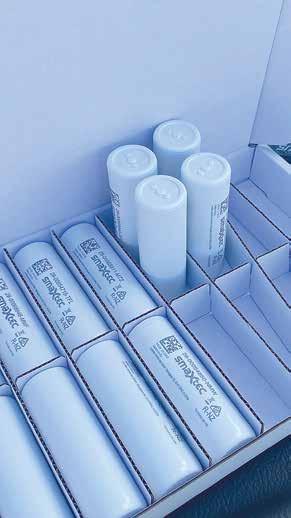
Which cows are due for hoof trimming? Which freshly calved animals need special attention, and potential mastitis cases are also automatically listed. Farmers
not only see which animals are affected but also receive concrete action recommendations from the AI-powered digital assistant, such as performing a CMT test.



WE’VE COME a long way in dairy farming over the past couple of decades. Genetics are better, sheds are more modern and we have more data at our fingertips than ever before.
But this progression, for some reason, doesn’t translate through to minerals. We see a lot of farms relying on the same old mix (and same old thinking) they were using 20 years ago.
It’s not that those approaches were wrong at the time; they were based on what we knew then. But we know more now, and when margins are tight and animal health is under pressure, mineral nutrition is one area where a few small shifts can mean big gains. Good enough isn’t always good
Plenty of cows get through calving without major issues, but that doesn’t mean their mineral programme is actually working well.
A cow can calve down, get milked, and head out to pasture, and still be underperforming in ways that are easy to miss.
Sluggish starts, inconsistent appetite, poor cycling, failure to conceive are things that are often hard to put your

finger on but are all signs that something is not quite right.
Often, the underlying issue is less than optimal mineral levels. There may be a good range of minerals in the mix, but for a cow to fully utilise the minerals, the mineral form can be critical.
Bioavailability matters
One of the biggest changes in mineral nutrition over the past 10 to 15 years is the shift from quantity to quality. It’s not just about ticking the boxes; the focus now is on maximising absorption.
It’s not just about the essential elements, cal-
cium, magnesium, or selenium and the levels on the label; it’s all about the potential availability of these minerals when in combination.
For example, some forms of magnesium, like magnesium oxide, are commonly used, but their quality can vary depending on the manufacturer and purity. Trace minerals like zinc, copper and selenium can also vary widely in their effectiveness based on their form (sulphate, oxide, chelate, rumen protected etc.) If the mineral forms are not right, depending on the diet and other minerals in the diet, a good percent-
age of what you’re paying may be passing straight through the cow.
The same goes for timing. A cow’s mineral requirements don’t start on the day of calving, but the weeks leading up to calving are vital.
Most of the critical shifts, like calcium mobilisation, liver loading, and immune priming must be addressed well before expected calving in order to achieve good results.
If your minerals are going in late or in the wrong form, they won’t be there when the cow needs them most.
Don’t leave springers behind
Springers are often treated as if they are simply in a holding pattern – keep them fed, keep them close, keep them quiet. But that three-week window is where we have the most control over how the calving goes. Transitioning cows properly has the potential to set the cow up for the entire lactation.
An effective transition program translates to increased productive performance (up to 10% gain), better reproductive performance, and higher immunity.
Mineral nutrition doesn’t fix everything,
but it’s an essential piece of the puzzle.
If your springer programme hasn’t changed in 10 or 15 years, it’s worth having another look. New research, better and more innovative mineral forms, and improved understanding of cow physiology can lead to more effective ways to support your cows in that final stretch.
Other sources of mineral matter too
It’s also important to factor in what the cows may be getting in their water and feed. In some areas, bore water can be high in iron or sulphur, and grasses can also be
very high in sulphur. This can seriously limit copper and selenium absorption. High potassium is a major issue during the transition period and needs to be mitigated by feeding a balance of other key minerals.
It is important during this period to look at the total makeup of the diet and address the limiting factors correctly. Applying the correct balance of major elements – Ca, Mg, P – along with the addition of rumen-protected or organic forms of selenium and key trace minerals in chelated form ensures absorption. Careful formulation can make all the difference to the end result. Time for a rethink?
If your current approach is working well and the cows are performing, that’s great. But if you’re seeing more metabolics than you’d like, or just not quite hitting the production or reproduction targets you are aiming for, it might be time to review what you’re feeding, how you’re feeding it, and when.
The solution isn’t feeding more, it’s feeding smarter.
• Chris Balemi is founder and managing director of Agvance Nutrition
@dairy_news facebook.com/dairynews
Set your farm up for a successful season with support from Farm Source. We’ve got proven products, the latest insights and practical advice to help your farming business thrive.
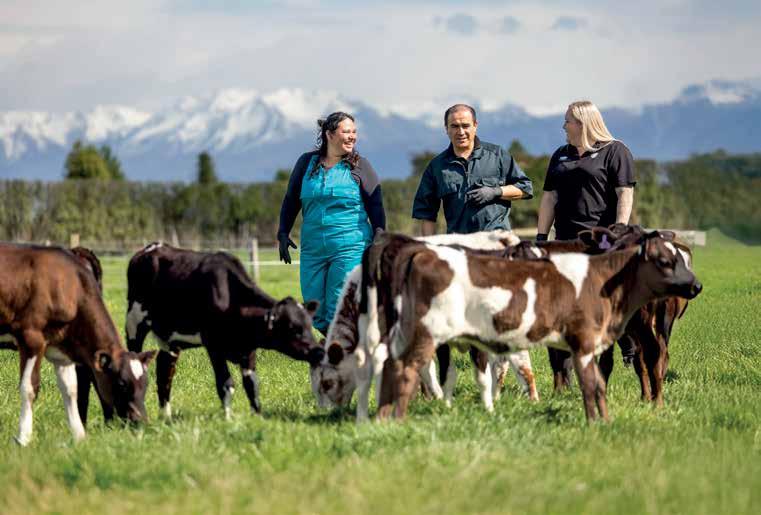
AS DAIRY farmers know all too well, the calving season brings with it significant nutritional demands on the herd.
Meeting these demands with effective and targeted mineral supplementation is key to reducing clinical issues and enhancing productivity.
CP Lime says that the use of its product Vitalise — a pelletised mineral supplement — is proving to be an innovative and practical solution for supporting herd health throughout this critical period.
Tackling clinical and sub-clinical deficiencies
Conditions like milk fever (hypocalcaemia), grass staggers (hypomagnesaemia), and facial eczema are prevalent across New Zealand dairy herds. Most farmers will experience at least one of these each season. While emergency supplementation during calving is standard practice, prevention is always preferable. Good mineral supplementation doesn’t just address visible health issues — it also supports cows at a sub-clinical level, helping maintain production and fertility even in the absence of outward symptoms. Waiting until blood tests reveal a deficiency often means the damage to milk production and longterm health has already
been done.
Comprehensive nutritional support
Vitalise provides more than just calcium and magnesium. It can be custom-blended with essential trace elements like copper, cobalt, iodine zinc and selenium, depending on specific herd requirements and seasonal challenges such as mating or facial eczema risk periods.
For herds on fodder beet diets, Dicalcium Phosphate can be added to prevent low calcium and phosphate levels, a common risk.
Biotin can also be a useful addition for skin and hoof health, and yeast cultures to improve rumen health.
Monensin, another additive option, improves rumen function and supports optimal cow condition, reducing issues like ketosis and bloat while enhancing in-calf rates and protein production.
CP Lime says Vitalise’s pellet form ensures every cow receives an accurate dose, reducing waste and cost. Its versatility — from standard to custom blends — and seamless integration into in-shed systems make it an ideal tool for modern dairy farming. The company says is it 100% utilisable, ensuring accurate dosing either via a mineral dispenser or by preblending with your local feed supplier.




SUCCESS IN calf rearing is often measured by minimising health issues and achieving target weaning weights.
Since its inception in 2017, Probiotic Revolution has brought in three different probiotic products to help calf rearers rear bigger healthy calves and around 120,000 calves a year are being reared on their products.
“Initially, to help calf health we relied on high doses of beneficial live bacteria in daily doses of Calf Xtreme boosting their immunity,” explains Matt Collier of Probiotic Revolution.
“In order to get over scours we just doubled or quadrupled the dose rate. This works extremely well if the issue is just Rotavirus. However sometimes the issue may lie with just a few calves in a pen, so to just treat
individual calves we now provide BioRescue paste in a convenient applicator. We have farmers who treat some extremely sick calves that have bounce back within 12 hours.
“We are so confident in this product that we are making it stronger this year and are providing an offer to allow many more to see its benefits.”
He also cites an example of Top Notch Calves who reared 7000 calves last year, but by using Calf Xtreme and BioRescue had 3% go through sick pens and just eight deaths.
Often bull calf rearers find their calves health is not the best when they arrive so last year the company proved BioCalf electrolyte, with its bacteria in it, to either help prevent scours or assist health when scours occur.

For some this is now an essential tool to minimise health issues.
Despite improving health, Collier claims the biggest benefit of using Calf Xtreme daily is to boost growth rates. He says research has shown
that if early milk volumes are high, better tissue is being laid down in the udder in the first 5 weeks of a calf’s life, and this impacts subsequent heifer milk production.
“With Calf Xtreme, we get to once-a-day feed
Probiotic products help calf rearers rear bigger healthy calves.
rates that are not far off ad-lib rates, but there is great consumption of meal, hay and grass and better rumen development.”
This approach prevents nutritional scours, when the excess milk car-
ries Calf Xtreme into the rumen, boosting digestion and intake of hard feed.
“The result is faster growth, with a survey showing calves reaching target weaning weights 11 days earlier,” he explains.
Collier cites an example of a Stratford farmer who used Calf Xtreme to change from feeding two litres twice a day to 7 to 8 litres once-a-day by day 10.
“Calves can’t normally get to this level of milk without getting scours but accompanied with a higher intake of meal and grass, they are initially growing at up to 1kg per day as well as better after weaning off milk. Milk production from these heifers compared with mixed age cow production has lifted from 74% to 86%. That’s a lift of 50kg milk solids or over $500 per heifer for about $10 of Calf Xtreme.”
Collier says the company is committed to promoting the use of their products with high milk rates to minimise health issues and raise higher producing heifers.

“ The Astronaut A5 Next gives me more control, and the cows more comfort.”

When the Lely Astronaut A5 Next takes over the repetitive process of milking, this allows you to allocate your expertise where it is needed most: like herd health, farm management and spending time with your family. Insights from Lely Horizon ensure the link between you and your animals by putting the right information at your fingertips. That way you can make decisions, plan activities and increase your efficiency.
Contact your local Lely Center to learn more about the Astronaut A5 Next.
The Astronaut A5 Next doesn’t only give you as a farmer more freedom, it also supports more autonomy for your herd. Autonomy is known to improve the well-being of cows. Our approach to automation - called ‘free cow traffic’ - allows cows to decide when they eat, drink, rest, or be milked. This freedom significantly improves their well-being, creating a calm, productive herd.
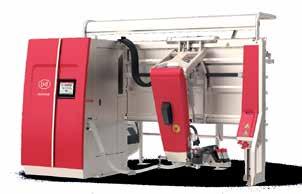
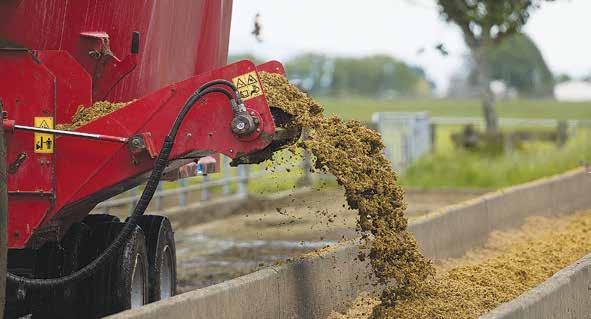

OVER THE past few months, I’ve had the privilege of speaking with many farmers at events and one-on-one.
In general, there’s a renewed sense of positivity and optimism about the season ahead. With milk price confidence holding, falling interest rates, and new tax incentives, many farmers are considering building or upgrading feedpad infrastructure as their next strategic investment.
While feedpads are nothing new, their value extends well beyond reducing feed wastage. They contribute to improved herd management, easier supplementation of minerals, pasture protection, reduced environmental impact, and increasingly, better cow comfort during periods of heat and cold. When combined with automatic gate openers, they can also save you time bringing cows to the shed.
growth by up to 50%, and repeated damage can compromise paddock recovery, increase regrassing costs, encourage the growth of weeds and less productive grasses and reduce long-term pasture production.
Managing hot and cold stress

Managing heat stress is a growing priority as summers become hotter and more humid. Heat stress reduces milk production and feed intake, and hits hardest during the afternoon and evening.
Feedpads offer practical ways to reduce heat load by:
• Providing shade, especially in covered or partially sheltered structures
• Offering central access to water and shelter
• Allowing feeding during cooler times of the day, while reducing the energy cows expend walking between paddocks
Feed efficiency and pasture
management
One of the clearest economic benefits of a feedpad is reduced feed wastage, especially when feeding valuable supplements like maize silage. Research from both New Zealand and Australia shows feed wastage on pasture can exceed 20–30%, particularly in wet conditions. On a well-managed feedpad, this figure can drop to just 5–10%.
For a 500-cow herd feeding 5 kgDM of silage per cow per day over 100 days, this reduced wastage could result in a saving of 30 tDM, worth around $10,000–$15,000, based on current prices.
Feeding on pasture in poor conditions not only wastes supplement, it also damages the pasture itself. Pugging can reduce short-term pasture
Cows experience heat stress when the Temperature-Humidity Index (THI) exceeds 68 for HolsteinFriesians or 75 for Jerseys. NIWA data confirms that in the Waikato, more than 70 days per year exceed this threshold.
At Owl Farm near Cambridge, cows experienced over 100 hours per week of thermal discomfort in the summer of 2021. This resulted in an estimated production loss of 6 kgMS per cow3, or around $30,000 in missed income for a 500-cow herd at a $10/kgMS payout.
Providing shade through feedpad infrastructure could reduce these losses by 50% or more provided there is adequate ventilation.
At the other end of the spectrum, cold and wet winter conditions, especially in regions like Southland, can increase daily energy demand by up to 35 MJME per cow, due to wind
chill and low temperatures.
Over a 90-day winter, dry cows wintered outdoors may require an additional 1.5 kgDM/day just to maintain body temperature. Using a covered or sheltered feedpad can reduce this energy cost, potentially saving $54 per cow, or $27,000 for a 500cow herd, assuming a feed cost of $0.40/kgDM.
Environmental value
Feedpads also offer important environmental benefits. When integrated with well-managed effluent systems, they can significantly reduce nutrient losses, particularly during wet winter and early spring weather.
New Zealand research shows that well-managed off-paddock facilities can cut nitrate leaching by 25–55%. Effluent collected can be stored and applied at appropriate rates during favourable weather conditions, improving nutrient use efficiency and reducing the risk of losses caused by overloading sensitive soils.
A smart time to invest
With strong milk price forecasts, reduced interest rates, and the Government’s tax incentive on new capital purchases, this is an opportune time to consider investment in infrastructure that supports long-term productivity, profitability, sustainability, and cow comfort.
When used well, feedpads are a strategic lever that can unlock more value from high-quality feeds like maize silage, protect pastures, reduce nutrient losses, and help manage climate extremes. They’re not about making farming more complicated.
If you’re considering building or upgrading a feedpad, talk to your consultant or contact one of our Farm Systems Specialists, Matt Dalley or Wade Bell, at www.pioneer. co.nz.




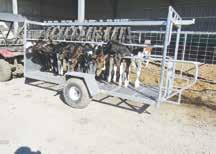
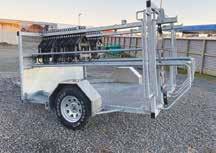

FOUNDED IN Germany
as recently as 1977, today, the Fliegl Group employs more than 1100 workers, offering an expansive range of transport solutions, from their base in Bavaria.
The company is also heavily involved in handling liquid effluents, with a range of tankers from basic farmer models, through to high spec, high output contractor units.
Distributed in New Zealand by the Power Farming Group, the Maxx Line Standard range is available ex-stock, with 8,600 or 10,600 litre capacities, with or without integral loading arms.
Featuring fully galvanised componentry, tanks feature integral baf-
fles, while large section tyres help protect against damage to swards, while hydraulic braking systems, means tankers stop safely and under control.
Equipped with a 11,000 litre/min pump, the base machine uses a 6-inch suction intake, while machines fitted with the integral boom loading system, moves to an 8-inch diameter intake for faster filling and turnaround.
Both capacities feature a sprung drawbar assembly, working in conjunction with an unsprung single axle. Standard equipment includes a silenced pump/compressor assembly, fill level indicators Hydraulic changeover valve for filling or emptying, double syphons and a full lighting kit.
Elsewhere in the extensive range, double

and triple-axle layouts complement capacities of 3000 to 27,500 litres within the MaxxLine, Maxxline Plus and Alpha Line families.
Offered with a choice of discharge/spread-


set-ups, by offering a pressure of up to 8kg per shoe, while also featuring mechanical or hydraulically activated section control, while featuring a 250mm hose spacing. A comfort function offers automatic folding and headland turns, while also incorporating antidrip stop feature when folded.
The Vari-Disc injection system allows operators to incorporate effluent in the top 5 to 10cms of the soil profile, offering easy access of nutrients to plants, while also eliminating odours in sensitive areas.
ing options, the entry level splash plate can be upgraded to the highlevel impact head unit to help reduce nitrate losses from by up to 30%.
For those looking for better utilisation and
more accuracy of application, more specialised trailing shoe and disc injection methods are available.
Both secondary application systems are “fed” by a screw auger system that includes dedicated traps to remove foreign objects and stones to remove the risk of blockages in the delivery hoses.
The Skate Drag Shoe applicator, improves on conventional trailing shoe
Using 530mm diameter, angled, spring loaded discs, the unit is available in 3m, 5.56m and 7.15m operating widths, with 11, 22 and28 outlets, each unit folding to less than 3 metres width for transport.


faster and requires less power than a small vertical mixing auger.
WHILE FEEDING dairy animals in New Zealand is largely centred around feed trailers, mixer wagons or baleage, one wonders whether there is a place for robotic feeders, particularly in South Island locations, where cows are housed during winter or full time.
Relatively new to NZ, the Euromilk brand sees the Rhino Vertical mixer wagons of 22 to 32 cubic metre, with twin auger configurations being sold by Farmchief.
Recently previewed at European trade fair, the Polish manufacturer was showing the Falcon 400 Pro feeding robot- a fully electric and autonomous machine that can cut and load silage from a 3.0m tall clamp.
The 4.0 cubic metre capacity mixing tub is equipped with six paddles and eight knives that mix and cut the feed, with the company suggesting that the configuration is
In addition to loading clamp silage, the milling head can also fill the tub with baled straw and hay. Complemented by a hatch at the top of the mixing drum is a hatch where concentrates and minerals can be added.
Depends on the forage material and travel distances, the robot is said to be capable of mixing and feeding up to 18t a day, which the manufacturer reckons is sufficient to feed up to 350 cows.
Robot navigation is taken care of by RTK connected GPS, with obstacles being detected by a 3D camera, operating in combination with ultrasonic sensors. Pneumatic bumpers are fitted around the machine perimeter, in addition to strategically located emergency stop buttons.
At 3.5m long and 1.5m wide, the vehicle requires a feed passage with a minimum width of 2.5m., allowing feed to be dis-
Auckland Stephen Pollard Ph 021-963 166 Waikato & Wellington
Lisa Wise Ph 027-369 9218
Christchurch Kaye Sutherland Ph 021-221 1994
tributed to the left and right, via and unloading belt with a 90cm discharge height.


1: Fastest Mixing Speed
- Asymmetrical mixing wedges
- Power mixing auger
- Rolled mixing chamber walls
- Consistent mix right through
3: Nationwide Backup and Support
- Four branches nationwide
- Factory trained technicians
- Significant parts stock holding
2: Longest Lasting Mixer Wagon
- Double overlapped welding
- High quality German steel
- Robust truck style chassis
- Double anti spill ring
4: Made for Me
- Over 2000 combinations
- 78 Versions
- 37 Models

“I’ve only recently started using a BvL Mixer Wagon and I’m already seeing an increase in production”
– WAIKATO DAIRY FARMER


Trusted by farmers for effective worm control with NIL MILK withholding periods and improved R.O.I
Studies in NZ dairy cows have shown the potent effects of EPRINEX® on parasites resulted in more daily milk, more milk protein and more milk solids.1,2

